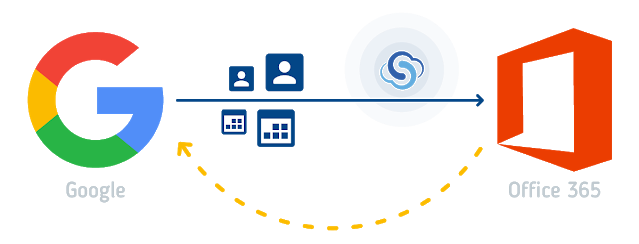
How to Fix G Suite Migration Failure
In this article, we’ll be walking you through the basic steps you need to take to resolve your G Suite migration issues.
Google has made huge strides with its suite of productivity tools. Their email and document collaboration platform, G Suite, is one of the best solutions on the market today. But what happens when something goes wrong?
Table of Contents:
What is GSMMO?
When it comes to migrating Microsoft Outlook data into Google Workspace (previously G Suite), IT administrators usually consider using GSMMO (or G Suite Migration for Microsoft Outlook).
GSMMO is a well-known desktop tool developed by Google, that lets users in an organization migrate Outlook PST files to a G Suite or Gmail account.
The tool can be downloaded from Google and installed on a computer where Microsoft Outlook is used. After the installation, users can easily choose what Outlook data they want to export – and the tool will transfer it to a desired G Suite account.
In a nutshell, GSMMO users can:
- Import mail, calendar, and contact data all at once or in separate stages
- Exclude specific mail folders from the migration, like mail sent before or after a specific date, junk mail, and deleted items
- Manage (pause and resume) and monitor the migration
- Run subsequent migrations that import only new data (avoiding data that’s already been imported)
As long as everything works, GSMMO can help IT admins save lots of time while setting up migrations for individual users in an organization. And the migration works great if only a few users are involved, or if the company is migrating small batches of data.
If you are reading this article, however, you will know that GSMMO is not always a breezy process.
Facing G Suite migration issues

If you have ever used the tool, you will know that it is not uncommon to face G Suite migration problems. Fixing them unfortunately requires some manual troubleshooting.
Issues usually arise after conducting large-scale migrations, particularly the ones involving huge batches of data.
Be ready to investigate as soon as:
- Some or all of the data was not imported from an old account
- Data was duplicated after importing
- The migration process timed out over a slow connection
- Certain error messages were received
Google provides some detailed guides on how to make the migration process as easy as possible. However, despite Google’s efforts, some users still do not always know how to get around a G Suite migration failure.
If you found yourself in such a situation, don’t be hasty to regret the decision to switch to G Suite in the first place. All you need is a good troubleshooting strategy.
Luckily, the SyncGene team is here to give just that. Read on to learn the steps you need to take when G Suite migration fails.
Check the type of failure
After a G Suite migration failure, the first step is to determine the type of issue you are facing. Issues can be twofold – blocking and non-blocking.
A blocking issue means that the migration was stopped (or blocked) entirely and that no data was transferred.
A non-blocking issue occurs when the migration is partially successful, but some messages or folders are missing on your new account.
This distinction is important, as the root cause for the G Suite migration failure as well as the solution is very different for each.
Verify GSMMO requirements
Usually, blocking issues can result from something as simple as typing an incorrect username or password. Or it might be that your Microsoft Exchange account lacks certain admin privileges. So, be sure to double-check this information.
It’s also important to verify the system requirements.
GSMMO isn’t supported for Apple Mac and only works on Windows. The following Windows operating systems are supported:
- Windows 10 (32 and 64-bit)
- Windows 8 (32 and 64-bit)
- Windows 7 (32 and 64-bit)
- Windows Vista SP1 (32-bit and 64-bit)
Outlook must be installed on the computer. The following Outlook versions are supported:
- Outlook 2003 SP3
- Outlook 2007 SP2 (or SP1 with hotfix)
- Outlook 2010 (32 and 64-bit)
- Outlook 2013 (32 and 64-bit)
- Outlook 2016 (32 and 64-bit)
- Outlook 2019 (32 and 64-bit)
Some other, more finicky troubleshooting steps might also include:
- Making sure the servers can reach and recognize EWS – select the Synchronization, Notification, Availability, and Automatic Replies option on the Exchange Server tab in the Microsoft Remote Connectivity Analyzer tool
- Checking Internet Information Services (IIS) logs to make sure that the migration service is connecting
- Verify that your TLS certificates are signed and valid
- Verifying that the super administrator has been assigned to a G Suite domain
- Ensuring that your server gets connections from Google mail servers
Sometimes, the issue may also be solved by double-checking all of the migration parameters and retrying the migration entirely.
For more information on the above steps, be sure to visit the Google Workspace Admin page.
Look up the error code

Resolving a non-blocking issue can take up more time and may require more “under-the-hood” methods.
You know that you are dealing with a non-blocking issue if you see errors in the transfer process as opposed to a complete failure of the transfer altogether.
To determine the reason for the issue, admins will have to wait until the migration ends to find and investigate the error messages. The list of error codes can be produced by forming a migration report. The codes can also be located in the GSMMO tracing logs.
You can find GSMMO trace log files on your computer here:
- Windows 7 and up – C:\Users\your-user-name\AppData\Local\Google\Google Apps Sync\Tracing\
- Earlier versions of Windows – C:\Documents and Settings\your-user-name\Local Settings\Application Data\Google\Google Apps Sync\Tracing\
If it comes to it, users can submit their trace logs to the Google Admin Toolbox Log Analyzer to save time on the investigation. Most of the issues can be identified within a few moments of submission.
If you can recognize the error code, you will be able to choose the troubleshooting method accordingly.
Here are the most common GSMMO error messages:
- 0x80040109 – there might be a problem with your anti-virus software, or another application, which is preventing access to the PST files. Turn off these applications temporarily to see if it resolves the issue. If it does, exclude the PST directory from your anti-virus scans.
- 0x80040111 means that the source profile seems to have been deleted. If this is the case, you will need to cancel the migration or create a new profile.
- 0x8004060c shows that one of the PST files that you want to transfer is too large for Outlook. You will then need to create a profile with a smaller size limit.
- 0x80072f78 – it seems that GSMMO is unable to sync some of your emails. The reason is likely due to network issues or large messages.
The code list goes on, so be sure to check Google Workspace Learning Center if you didn’t find the necessary code here.
Don’t hesitate to reach out for help

Needless to say, troubleshooting a failed G Suite migration manually might be slippery, as it requires a lot of “know-how” and technical skills.
At some point, you will definitely have to turn to Google for help. To say the least, their support website has collected a wealth of information that includes step-by-step guides for G Suite migration failures.
Also, be sure to visit their Help Center where others have shared their troubleshooting steps and product experts can also jump in to answer questions.
Of course, one of the simplest solutions to fix a G Suite migration failure is to contact the SyncGene support team.
As a Microsoft Gold Partner, SyncGene specializes in G Suite migrations and would be happy to resolve your issues and help you get back on track.
Even better – you can avoid failures altogether and use SyncGene Enterprise to migrate Calendars and Contacts across any cloud-based platforms.
Avoid G Suite migration failure with SyncGene Enterprise

As you may have noticed, although GSMMO might seem like a simple and fast solution at first, in some cases it can cause more problems than it solves.
That’s why companies more often than not consider third-party applications for handling complex migration scenarios. And with the help of SyncGene Enterprise, you are guaranteed a smooth, stress-free G Suite migration process.
SyncGene Enterprise can perform Calendar and Contacts transfer for any number of mailboxes, saving you all the hassle of a complex migration.
Whether your business is acquiring another company or merging different mailing systems, data transfer to G Suite will always be secure and fast with SyncGene Enterprise.

Here are a few features that the SyncGene Enterprise service offers:
- Integrate contacts and calendars from Google. Migrate calendars, contacts, and tasks from Google Workspace to Office 365, or vice versa. All will work automatically and in the background, to avoid errors and save time.
- Nothing to install. The solution is easy to use. No installation is needed, all data syncs automatically in the cloud.
- Use the Admin Panel for centralized administration. Admins can manage member accessibility, control user data, and see the synchronization status in real-time for each account.
- Add an unlimited number of users. Import an entire organization’s worth of accounts at once, with just a few clicks.
- Customization and deployment. If you need a custom solution for your business, SyncGene can be flexible. We will adapt specific features to your requirements in an optimal time frame. Discuss all customization solutions and plan deployment with your Dedicated Account Manager.
- Safety and security – guaranteed. Feel safe, SyncGene does not store synchronized data. It works as a tool to pass your information and keep it updated. SyncGene is hosted on Microsoft Azure – the most trusted and reliable cloud service in the world.
Check out our article on how to migrate from G Suite to Office 365 with SyncGene Enterprise.
To sum up
There you go, these are the basic steps that you should consider when facing a G Suite migration failure. And now you know that you can avoid G Suite migration failure altogether with SyncGene Enterprise.
With SyncGene Enterprise, migration will be a painless process for IT administrators, managers, and end-users.
But you don’t have to believe us – see the benefits for yourself by booking a demo today!
And, if you have any questions, send us an email, give us a call, or start a Live Chat.
Related:
Everything You Need to Know About G Suite and Outlook Connection
G Suite Calendars and Contacts One Time Migration to Office 365: Case Study
G Suite Calendars Contacts Migration to Office 365: Case Study
Read more:








%20white.svg)
.svg)